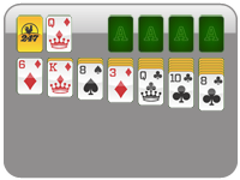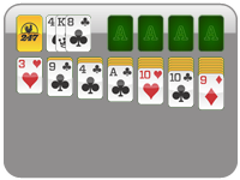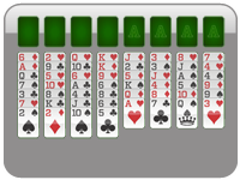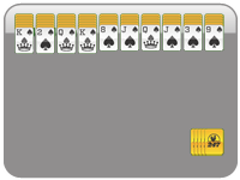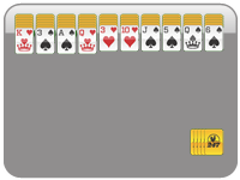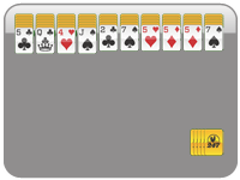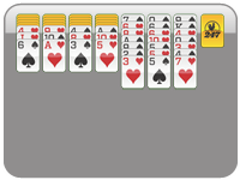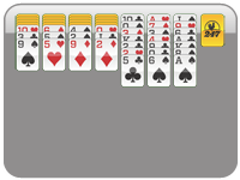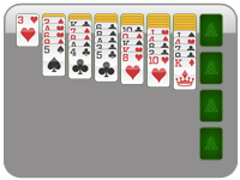The History of Solitaire, From Marbles on a Wooden Board to Solitaire on the Computer

Have you ever wondered the history of Solitaire, the world’s premiere single-player card game? It might be more complex than you’d think! From the emergence of card-based games in Chinese history to Solitaire’s first introduction into the digital age, it’s certainly a story for the ages.
It’s no surprise that we love Solitaire in and out. Let’s explore its past!
First off, what’s the history of card games?
Many cultures throughout history across the globe have had their own forms of competitive mind games. Historians believe that games utilizing cards or card-like pieces originated in 9th-century China.
The first historical reference to such a game comes from a text entitled The Collection of Miscellanea at Duyang, which details Princess Tongchang, daughter of the Tang Dynasty Emperor Yzong. The story mentions a “leaf game,” believed to be printed cards of some sort. The emergence of card games in China would line up with the Tang Dynasty’s history of groundbreaking technological advancements in wood-block printing.
Playing cards and dominoes have roughly the same origin since there’s no clear distinction between the two in China other than material.
It would take until the 14th century for playing card decks to become common in Europe, where the traditional four-suit deck of 52 cards began to popularize. Originally a luxury item for the upper class, being hand-painted, the prestige surrounding them grew a demand for more cheap, accessible card decks. Early printing in Germany met that demand.
With their new popularity, playing cards became a popular curiosity and gambling item across Europe, and people created countless new games every day.
A definitive timeline of Solitaire history
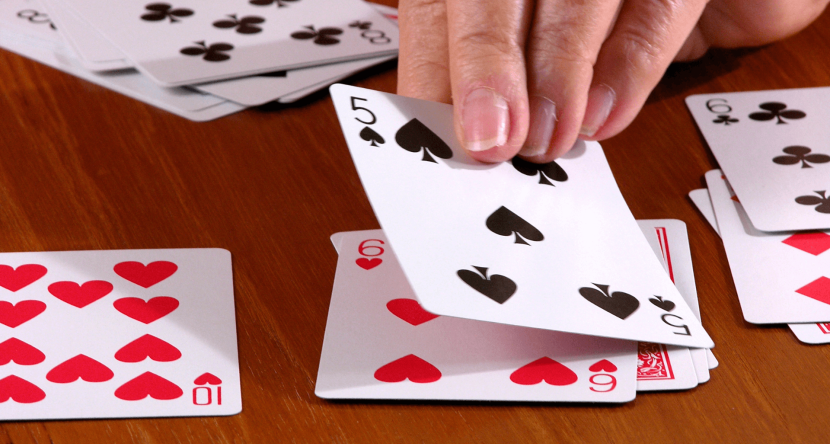
Experts debate the exact Solitaire origin, with roots stretching back to Victorian-era France and even further beyond. Let’s look at how we got here. Let’s look at how we got here.
When and where did Solitaire originate?
The name Solitaire is often used as a catch-all title to refer to various styles of one-player games, which don’t necessarily need to involve cards. This also gives us a clue as to why Solitaire is called Solitaire.
You may be wondering, why is it called Solitaire? “Solitaire” comes from the French word for “solitary.” The variation of Solitaire many of us know, simply called “Solitaire” in the US and Canada, is also called Klondike. However, the Solitaire family of games is called Patience in European countries—namely England, Germany, and Poland—for the patience required to beat them; Scandinavian countries call it “cabale.”
Whatever you call it and whatever version you play, there’s no denying its global popularity.
So, who invented Solitaire? There’s no definitive answer to who created Solitaire but if you were to ask how long has Solitaire been around, you can expect some answers. One of the first documented versions of a Solitaire game was played on a wooden board with pegs or marbles. The earliest such example is a French engraving from 1697 by Claude Auguste Berey depicting Princess Soubise playing the game.
However, Solitaire games didn’t appear in literature until the late 18th century. The earliest known description of a patience game was in a 1783 edition of the German publication Das neue Königliche L'Hombre-Spiel; however, this was a two-person game.
The earliest collection of published patience games (as we know them) was in Russia in 1826. Several others followed in Germany, France, and Sweden. The first English translations of these books were published in the 1860s.
Obscure Solitaire Origins to Rising Popularity in Europe
Some experts speculate that Solitaire card games initially became popular in the Baltic region of Europe due to an interest in cartomancy and tarot near the end of the 18th century. Since Solitaire tends to require a fair amount of luck, winning a game would be a sign that the divinator’s prediction would come true.
As mentioned in its origins, the initial rise of Solitaire’s popularity en-masse came in mid-19th century Europe through game literature. Card games as a whole became quite popular once printing made them more available.
One can likely attribute the “foundations” of Solitaire’s rise in popularity among players to its ease of play and relaxing pace. As we’ve seen, many kinds of Solitaire-type solo card games exist.
Who invented the different types of Solitaire card games?
Many variations of solitaire games exist, with creators documenting them in published collections of rules for different card games, including all of the books mentioned thus far. Unfortunately, that makes it difficult to pinpoint where each variation came from. However, there are a few we know for sure.
The Klondike version of the game likely had many predecessors, but the name originates from Canada during the Klondike Gold Rush. Another name for this version is Canfield, popularized in the United States in the 20th century as one of the most difficult patience games to win. Ironically, its name derives from its inventor, Richard A. Canfield, one of American history's most successful gamblers and casino owners.
One of the most popular Solitaire variations, a type of two-deck patience known as Spider Solitaire, was introduced in 1949. It gained its name from a spider’s eight legs to reference the eight foundational piles the game requires to win.
Regardless of the version, Solitaire’s power was staying, as it would soon be at the forefront of a new age of digital gaming.
Uses of Solitaire on personal computers
In 1990, Microsoft packaged a Solitaire program with its Windows 3.0 operating system, the third iteration of the system for personal computers. While this Solitaire on the computer wasn’t the first home computer Solitaire program, beaten by Solitaire Royale in 1987, Microsoft’s built-in game became the definitive experience for Solitaire on the computer.
The program has an interesting origin. Originally programmed by Wes Cherry and Susan Kare, the pair intended Microsoft’s flagship Solitaire game to make new users of the Windows operating system—or PCs in general—feel more comfortable with graphical interfaces and mouse controls they might not be familiar with.
At its original height, historians estimated it to be the third most popular Windows application ever. The program became a mainstay in Windows installations all the way until Windows 8, when Microsoft introduced the Microsoft Solitaire Collection.
The ease of access a digital program brings to the game can’t be understated. You don’t need a lengthy setup time, and you could achieve truly random card distribution every time. Solitaire continues to be one of the most played digital games today, all thanks to a legion of dedicated players all across the globe!
Enjoying Solitaire in the modern day

Millions of hands of online solitaire are played daily across countless different platforms. Its accessibility is rivaled only by the game’s fantastic replayability! Solitaire is a one-of-a-kind genre of games. So much so that despite the long and complex history of Solitaire, the game still hasn’t aged. It’s a puzzling, contemplative game of strategy that all ages can enjoy.
If you want to see why this game has stood the test of time, feel free to check out Solitaire for yourself!
Solitaire Games
More Solitaire Games
More Games
Solitaire News
Disclaimer
DISCLAIMER: The games on this website are using PLAY (fake) money. No payouts will be awarded, there are no "winnings", as all games represented by 247 Games LLC are free to play. Play strictly for fun.

